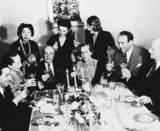Grete Stern: Portrait of Clément Moreau (around 1936/1938)
The photographer Grete Stern and the painter and graphic artist Clément Moreau met in Argentina, where both were living in exile. Grete Stern had married her fellow student at the Bauhaus, Horacio Coppola, in 1935.
Grete Weil: Letter to Bruno Frank (26 August 1945)
Almost four months after the liberation of Amsterdam by the allies, Grete Weil made contact with the author Bruno Frank and told him about her circumstances and the events of the last years. Bruno Frank and his wife Liesel were good friends of the Dispekers, Grete Weil’s family from his time in Munich. Grete Weil: Portrait photograph of Franz Werfel (1938)
Before she emigrated to the Netherlands in December 1935, Grete Weil completed her training as a photographer with the famous Munich photographer Eduard Wasow. In spring 1938 she took over the workshop of photographer Edith Schlesinger, who had emigrated to the US.
Grete Weil: Tramhalte Beethovenstraat, manuscript (1963)
After the poor reception of her first publication, the story Ans Ende der Welt (To the End of the World) by the East Berlin publishing house Volk & Welt in 1949, Grete Weil worked as a playwright and wrote, among other things, the libretto for Hans Werner Henze's opera Boulevard Solitude. Her prose text Antigone, which she had written at the beginning of the 1950s, remained unpublished.
Grete Weil’s armband from the Jewish Council for Amsterdam (1942/43)
In early summer 1942, Grete Weil received a call to “report to work” – the announcement of her imminent deportation. In order to not have to go underground and to be able to continue to support her mother, she accepted a position in the Jewish Council in Amsterdam.
Grete Weil’s registration certificate for Jews in the Netherlands (1941)
A few weeks after German troops invaded the Netherlands, the occupation authorities began with preparations to record the Jewish population. In January 1941 the “order of the Reichskommisar for the occupied Dutch areas concerning the obligation of persons who are entirely or partly of Jewish blood to declare themselves” came into effect.
Group photo of Albert Bassermann’s birthday party (1942)
Many German emigrants in America were heartened by the news of actor Albert Bassermann’s arrival in New York on 15 April 1939. One of the greatest character actors was now among them, not out of necessity, but out of principle.
Group photo taken at the Yaddo artists’ colony (1939)
An encounter between people and languagesThe Yaddo artists’ colony wasn’t only a “comical writers’ foundation”, but also a place where writers, composers and translators could establish contact with one another and work together. Since 1926, the foundation had been providing scholarship holders from areas of the arts with the chance to spend 8 weeks working at the colony.
Gustav Wolf: Emigranten, a poem (12 January 1942)
During the initial years of his New York exile artist Gustav Wolf was provided helpful support through his friendship with Max Fischer. Like Wolf, he had also fled Nazi Germany.
Gustav Wolf: Letter to Carl Zigrosser (July 12, 1941)
In July 1941, Gustav Wolf attempted to promote his flagging artistic career in American exile. He wanted to have a secure income, at least for a period of time.











